Abstract
The main purpose of this study was to investigate the hydrophobic effect and chemical changes induced by thermo-treatment and alkyl ketene dimer (AKD) on the surface properties of Alder (Alnus cordata (Loisel) Duby) wood before and after an artificial weathering test. Thermal treatment was conducted at a temperature of 200 °C for 4 h in a thermo-vacuum cylinder. Then, the paper sizing agent, AKD at different concentrations of a solution of 0.1%, 0.5% and 10% was used as a potential hydrophobizing reagent for untreated and thermally treated alder wood surfaces. The contact angle measurement, ATR-FTIR analysis and colour variation were carried out for the samples. The preliminary results revealed that the contact angle values of the wood materials increased with thermal modification. However, the influence of the thermal treatment on hydrophobicity was small when compared to the substantial effect of the AKD application in this respect, and also after the artificial weathering test. The FTIR analysis supported the hypothesis that AKD could make bonds chemically stable even when using a small concentration of AKD. The findings acquired in this work provide important information for future research and the utilization of the AKD on lesser-used wood species.
1. Introduction
It is known fact that wood undergoes degradation processes when exposed to exterior conditions. In particular, the surface is affected by exposure to light and water. The hygroscopic nature of wood produces some undesirable properties [1]. Due to water absorption and desorption, it is easily subjected to the biological attack of fungi and insects as well as dimensional instability. All of these adverse factors influence the overall properties of wood in outdoor use.
To enhance the performance of wood under critical environmental conditions, different approaches may be applied. There are several chemical treatments to preserve wood surfaces, but these could cause toxic emissions during the production, service life and after use [2]. An important alternative to preserve wood is thermal modification.
As noted by Hill [3], the heating temperature used during the treatment provoked changes in the wood. Thermo-treatment removes water from wood and causes changes in the chemical composition of wood and ultrastructure through autocatalytic reactions and cross-linking of the cell-wall constituents [4,5]. The wood became less hygroscopic, and an improvement in dimensional stability could be observed [6]. However, thermally modified wood shows a general decrease in mechanical properties. The colour change is not permanent in time when the wood is exposed to exterior situations. Decay resistance does show some improvement, however is not recommended to use thermally treated wood in ground contact situations [3,6].
Hemicellulose degradation starts with the hydrolytic cleavage of acetyl followed by carboxyl groups from the side chains, which in the presence of temperature and water, leads to the formation of acetic and formic acids. Afterwards, organic acids catalyze the further hydrolysis of the cell wall polysaccharides. The corresponding sugars can be further dehydrated to aldehydes, with furfural and hydroxymethylfurfural being typical products originating from pentoses and hexoses [7,8].
The degradation of amorphous cellulose also occurs which implies the inaccessibility of hydroxyl groups to water molecules. This is one of the factors that contribute to a decrease of equilibrium moisture content. However, the lignin degrades and its content increases and new methylene bridges arise which are responsible for crosslinking [9,10,11]. At the same time, heat treatments modify the wettability of wood, which is directly related to the chemical changes of the wood structure, especially to the degradation of the hemicelluloses.
The effectiveness of water-repellency treatment can be defined as the ability of a treatment to prevent or control the rate of liquid water uptake [12]. Several direct and indirect analytical approaches have been adopted to wood samples, including the measurement of wettability through the water contact angle (WCA) [12,13]. The relevance of the determination of the wettability of wood and its significance in wood science was critically discussed by Petrič and Oven [13].
Numerous investigations were carried out on the wettability changes of wood during heat treatment. General statement thermo-treatment has induced a reduced wettability [3]. However, Huang et al. [14] stated that induced weathering increased the wettability of heat-treated wood.
Weathering is a complex process that modifies and degrades the overall molecular structure of wood and wood-based products. The ultraviolet (UV) radiation is one of the main responsible of the photodegradation, causing the fastest and the strongest degradation of the wood components. The quantum energies of UV light break many of the chemical bonds presented in the wood constituents [15].
Thus, a certain degree of surface degradation of the treated wood used in outdoor conditions would still be expected. Therefore, surface protection of thermo-treated wood products would be necessary to enhance the overall effective service life of the final product [15].
While thermal modification of wood is an important alternative for improving technological performance, numerous studies have proposed making wood materials water-repellent by using various derivatives of anhydride, epoxide, alkyl chloride, aldehyde and chlorosilane [16], such as octadecyltrichlorosilane, which according to Hui et al. [17], have exhibited hydrophobic properties. Other chemical treatments of esterification, such as acetylation of cellulose [18] or natural fibers [19], can also be used.
An interesting treatment regarding the use of fluorine, which is a chemical element with the highest electronegativity, has led to hydrophobic characteristics in carbon fiber [20]. For wood, fluorination converts the bond between the carbon and hydroxyl groups into C–F bonds, thus making it hydrophobic [21].
Alkyl ketene dimer (AKD) can be also used to make wood surfaces hydrophobic [22] and is a widely used hydrophobization chemical in the papermaking industry [23]. Compared with other chemical compounds, it exhibits low toxicity, requires no special equipment, and the solvents involved are recyclable. Each AKD molecule is composed of two alkyl chains and one hetero four-member ring that reacts to hydroxyl groups to bind β-ketoester linkages [23,24].
There were three different hypotheses of the mechanisms of the reaction of AKD with cellulose materials. The first hypothesis states that the substance could react directly with cellulose hydroxyl (principally with C6 hydroxyl) as it is less sterically hindered when compared to the hydroxyl group on C2 or C3 [25,26,27,28]. The second one indicates that the mechanism of the reaction of AKD and water molecules is faster than cellulose even if it produces an unstable β-keto acid [29,30]. The third hypothesis takes into account whether the reaction could occur between AKD molecules forming an oligomer [31]. Other authors [32,33] have argued that the reaction between the hydroxyl groups in cellulose and AKD is essential to repel water.
However, although many studies were carried out related to the use of AKD on the wood surface, the investigation of the chemical reaction after an accelerating weathering test remains poorly investigated.
During the last decades, the demand for sustainable material removing the use of toxic chemicals obtaining materials with great potential and durability has been increasing. For this reason, it has raised the necessity to modify the wood products. High-value wood resources might be obtained with different processes, including impregnation, chemical modification or thermal treatments, among others. The potential economic gain is more attractive when considering lesser-used or minor wood species of relatively low market value.
The effects of thermal treatments on properties of lesser-used hardwood species, such as Alder wood, have been understudied [15]. Italian Alder (Alnus cordata (Loisel) Duby) can grow very rapidly (up to 30 m tall and reaching 70–80 cm in diameter) in the soil at increased humidity along watercourses [34,35,36]. Italian alder grows along the watershed, even at high altitudes mainly in Southern Italy. These species have been introduced in Sardinia and the Southern Alps. Recent plantations were also established in other European countries including France, Spain, Portugal, England, and the Netherlands. It has also been recently introduced in New Zealand and Chile [15]. It shows a density of 0.560 g/cm3 at 12% moisture content, while the strength is variable with density. Normally, the compression value is approximately 36 N/mm2, and the bending approximately 80 N/mm2 [37]. It is mainly used for energy, but also for furniture, paneling, plywood, and paper pulp. Italian Alder wood, similarly to Black alder, for its machinability, colour homogeneity, and pleasant appearance, could be an alternative for different industrial destinations [38,39].
At present, this wood material has low commercial value for different reasons, mainly related to the economic competition caused by wood species from abroad. To reduce the importation of wood material, an environmentally friendly improvement of the properties of native or adapted minor species is one of the new challenges for wood researchers.
Our research assumes a gradual increase of hydrophobicity of untreated and thermo-treated Alder woods using AKD. The choice of a water-repellent agent, such as AKD, for the superficial processing of Alder wood is conditioned by the need for the application of a low toxicity chemical agent able to maintain the properties of natural wood by improving its water-repellency.
This study combined thermal bulk-modification alder with additional surface treatment using AKD at different concentrations. The main purpose of the present study was to investigate the hydrophobic effect and chemical changes induced by thermo-treatment and AKD on the surface properties of Alder wood before and after an artificial weathering test. The changes in surface hydrophilicity were investigated utilizing WCA measurements. The attenuated total reflectance-Fourier transform infrared spectroscopy (ATR-FTIR) was used to investigate the chemical changes of the wood surface.
2. Materials and Methods
2.1. Sample Preparation
Four Alder (A) trees were selected and harvested in the Apennine forest (Calvello municipality, Basilicata Region, Southern Italy, 40°28′12.1′′N 15°51′59.3′′E). The logs were then sawn in a commercial sawmill in boards of 40 mm (tangential) × 200 mm (radial) × 2200 mm (longitudinal). For this study, 1 m3 of boards were randomly selected. Half of the boards were initially dried to 0% moisture content in a vacuum ranging from 185–200 mbar at a temperature of 90 °C for 4 h. The drying process started at an initial temperature level of 30 °C and increased to 90 °C at 5 °C per hour intervals. In the next step, the thermal treatment was applied to the boards by gradually increasing to a final temperature of 200 °C, under 220–320 mbar of pressure conditions for 4 h in a thermo-vacuum cylinder (WDE-Maspell s.r.l., Terni, Italy). Further information on this technology has been described by Todaro et al. [40].
After the thermal-vacuum treatment, 24 defect-free specimens (5 mm × 50 mm × 50 mm tangential, radial and longitudinal) were cut and randomly assigned to groups according to Table 1.

Table 1.
Experimental design of untreated and thermo-treated alder samples.
The untreated and the thermo-treated wood samples were then exposed for one month to a climatic chamber in a controlled environment (20 °C and 65% of humidity). The samples were immersed in three different AKD/toluene solutions at an ambient temperature for 10 s each.
The AKD solutions were obtained by dissolving AKD wax C18 in the toluene solvent to achieve: 0.1%, 5% and 10% concentration (w/w). Then, the samples were put under a fume hood where the toluene was allowed to evaporate overnight. Finally, the samples were kept at the standard climate of 20 °C and 65% of the relative humidity.
2.2. Water Contact Angle (WCA)
The angle formed between the wood surface and the line tangent to the droplet radius from the point of contact with the wood surface was determined using digital image analysis software (Drop Shape Analysis, Krüss GmbH, Germany). Demineralized water of 6 µL was employed for the measurements. The WCA was recorded every 0.5 s for a total of 120 s, thus for each drop, a total number of 240 WCA values were recorded. Each measurement was undertaken 3 times on each of the 24 wood specimens before and after the weathering test.
2.3. ATR-FTIR Analysis
Each of the 24 samples was analyzed, before and after the weathering test, with an ATR-FTIR spectrometer (PerkinElmer, FT-IR Spectrometer Frontier, Perkin-Elmer Inc., Norwalk, CT, USA.) with Spectrum™ Software operating on 4 scans and 2 cm−1 resolution. The spectra were recorded within a wavelength from 650 cm−1 to 4000 cm−1 and were baseline corrected and normalized by the software. To normalize the infrared spectra, the band referred to 1025 cm−1 in the fingerprint region was used. For the samples with AKD, the band usually used was at 2917 cm−1
2.4. Artificial Weathering Test of the Samples
The wood samples were tested in artificial weathering using the fluorescent UV lamp and water test. The test was carried out according to the European standard (EN 927-6) and the experiment lasted one week. The cycle started with 24 h conditioning, followed by 2.5 h UV and then 0.5 h water spraying. These two phases were repeated for 6 days. All the samples were put in a chamber test for 116 h having 24 h conditioning, 15 h spraying water, and 77 h UV irradiation.
The apparatus was equipped with ultraviolet A (UVA) 340 nm lamps maintaining the constant temperature with a value of 45 °C during the conditional phase and 60 °C during the UV irradiation. The irradiation set point was 89 W/m2 at 340 nm and the conditions during the spray phase were from 6 L/min to 7 L/min during UV off.
2.5. Colour Variation
The colour changes during aging were constantly monitored on the specimens based on the method of the Commission International de l’Eclairage (CIE) using color parameters, L*, a* and b* [15] and their average values were calculated for each treatment.
Colorimetric measurements, by using Minolta CM-2002 spectrophotometer (Minolta Corp., Ramsey, NJ, USA), were also performed on three separated locations and repeated three times before thermo-treatment, after thermo treatment and after AKD. In addition, the measures were repeated after weathering test.
3. Results and Discussion
3.1. Water Contact Angle (WCA)
The results of the WCA measurements of untreated and thermo-treated alder wood, before and after UV, were displayed in Figure 1 and Figure 2. As expected, water was absorbed faster by the untreated wood (A) compared to the thermo-treated wood (ATH) (Figure 1a and Figure 2a). The lower wettability on the wood surface after thermal treatment could be ascribed to several events taking place in the wood. One of the probable causes are the migration of non-polar extractives to the wood surface during heating [7,14,41].
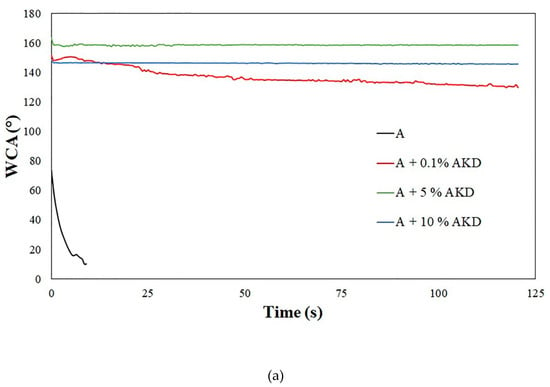
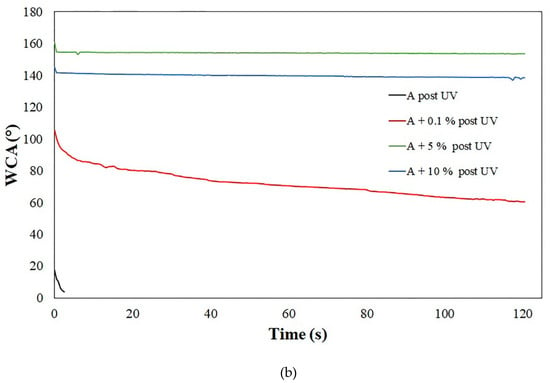
Figure 1.
The water contact angle (WCA) during time on untreated alder samples (A), before (a) and after UV exposure (b).
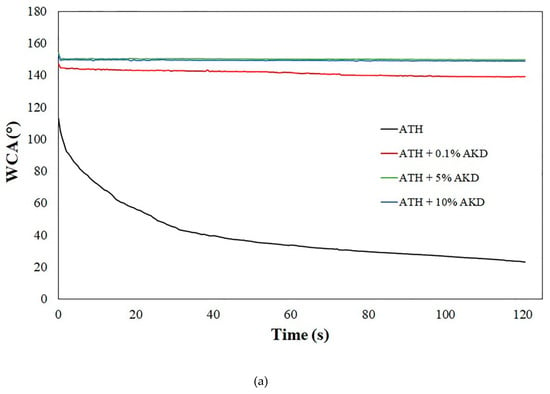
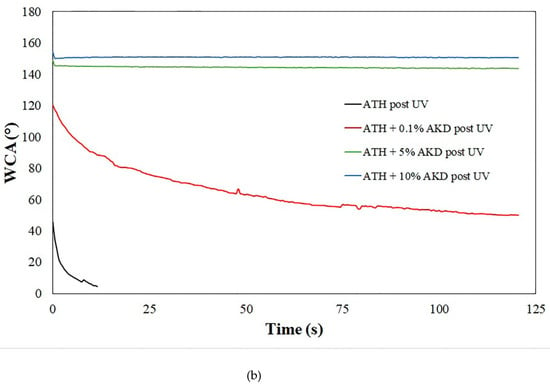
Figure 2.
WCA during time on thermo-treated alder samples (ATH), before (a) and after UV exposure (b).
Several other parameters also play an important role in the reduced hygroscopicity of wood surfaces [4,42]. For example, the different types of reactions between the cell-wall components occur during heating and they imply a cross-linking between the lignin and polysaccharides, and a reduction in free hydroxyl groups. At high temperatures, the hemicelluloses, as one of the first structural components of wood that changes during heating [6], may undergo oxidation and pyrolysis reactions. They can also cause changes in compounds, like the formation of furfural polymers, which are considered to be less hygroscopic compared to hydroxyl groups [43]. The hydrophobicity of both A (10.1 after 9 s) and ATH (23.1 after 120 s), before artificial weathering, were greatly improved after the application of AKD (Figure 1a and Figure 2a). The hydrophobic effect of the AKD substance could be caused by the esterification reactions between AKD and wood compounds, like hemicellulose [23,24].
After artificial weathering, the WCA of A (3.9 after 2.5 s) and mostly ATH (4.6 after 11 s) decreased significantly (Figure 1b and Figure 2b). This result is similar to other published studies. The initial WCA of the heat-treated specimens were higher than the untreated samples [44], but after the weathering test, the difference in WCA between the control and TH was limited. Some of the previous studies stated that these changes in the wettability were strictly due to the combination of structural and chemical changes of wood surfaces [45,46].
The Figure 1 and Figure 2 suggest that after artificial weathering, the hydrophobicity remains unchanged for the A and ATH wood surface treated with 5% and 10% of AKD. However, for the wood sample A + 0.1% AKD (from 129.8 to 60.58) and ATH + 0.1% AKD (from 139.0 to 50.21), a decrease of WCA was observed.
3.2. ATR-FTIR Analysis
In Figure 3, the FTIR spectra before UV exposure, between the wavelengths of 4000 cm−1 and 600 cm−1 of both untreated (A) and thermo-treated alder wood (ATH), are displayed.
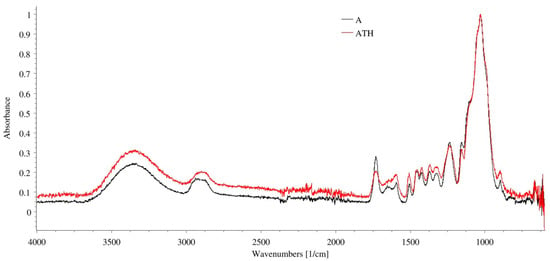
Figure 3.
Comparison of FTIR spectra of alder wood (A and ATH, respectively).
As stated by Colom et al. [47], in the spectra, two different areas can be observed: The first was between 3600 cm−1 and 2700 cm−1 and it was referred to the stretching vibrations of O–H and C–H groups; the second between 1800 cm−1 and 800 cm−1, is called the fingerprint region, assigned to stretching vibrations of wood structural compounds.
Clear differences could be noticed in the fingerprint region. The first important difference was the intensity of the band of 1734 cm−1, assigned to the C=O stretching vibration of acetyl or carboxylic acid which was slightly smaller in ATH. As stated by Colom et al. [47], this variation indicated the cleavage of the acetyl side chains in the hemicelluloses.
After thermo-treatment, a band at 1335 cm−1 appeared. A previous study has used this doublet to monitor the described degradation process. Colom et al. [47] reported that a decrease in the ratio between the absorption band of 1335 cm−1 and 1316 cm−1 signifies an increase in crystallinity. This indicated that the degradation process was more intense in the amorphous cellulose component than in the crystallized portion.
Another significant difference was in the doublet at 1610–1595 cm−1 which occurred only in spectra A. The presence of this doublet before the heat treatment showed that the lignin was a mixture of the guaiacyl and the syringyl components [48]. After thermo-treatment, the strong decrease of a band at 1610 cm−1 meant that only the degradation of the the guaiacyl occurred, most likely due to its easier degradation compared to the syringyl [49]. This behavior was confirmed by bands at 1595 cm−1 and 1510 cm−1, based on the aromatic skeletal vibration in the lignin having a similar intensity before and after the treatment. This result can be attributed to the predominant syringyl units, which remained unchanged after the heating process [47].
There were other signals that did not change after thermo-treatment but were equally important—1377 cm−1, 1240 cm−1, 1165 cm−1, and 1030 cm−1 were assigned to C–H, C–O–C and C–O stretching vibrations of the different groups in carbohydrates, and 898 cm−1 was connected to the amorphous region of cellulose.
In Figure 4, the FTIR spectra of A and ATH, pre and post UV, are displayed showing only the fingerprint region.
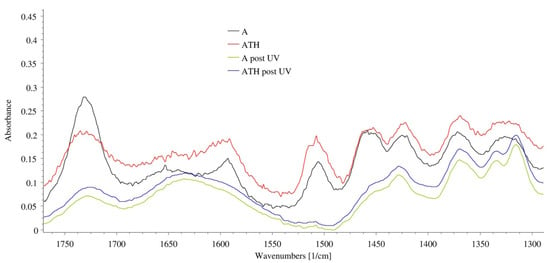
Figure 4.
Comparison of FTIR spectra of A and ATH before and after UV of the fingerprint region.
After UV treatment, many changes take place in the fingerprint region (Figure 4). The bands 1595 cm−1, 1510 cm−1, and 1465 cm−1, assigned to the lignin component, decreased significantly in both A and ATH as a result of the irradiation process. This means that the structure of lignin polymer was degraded to a significant extent. The decrease of bands at 1595–1510 cm−1 showed that the guaiacyl nuclei (1510 cm−1) are more sensitive to the artificial aging degradation process that the syringyl nuclei (1595 cm−1). In contrast to what was claimed by [50], the absorbance to stretching vibration of acetyl or carboxylic acid at 1730 cm−1 decreased greatly. After UV, the doublet at 1335–1316 cm−1 assigned to the cellulosic component developed, resulting in a high crystallized cellulose content. During the weathering test, the degradation of the amorphous cellulose component was more intense. The band at 1426 cm−1 related to CH2 stretching, shifted at 1430 cm−1 after the degradation of amorphous cellulose [51].
For a better understanding of the effect of the hydrophobizing reagent on wood surfaces, it is essential to analyze, in advance, the ATR-FTIR spectra of AKD (Figure 5).

Figure 5.
FTIR spectra of alkyl ketene dimer (AKD).
The specification bands of AKD are at 2915 cm−1 and 2848 cm−1 which characterize the C–H stretching vibration representing methyl and methylene groups of the alkyl chain in the AKD molecule. There are other relevant signals, 1848 cm−1 connected to the stretching of C=C and the band at 1700 cm−1, related to the group C=O. These characteristic signals related to AKD can be observed also in Figure 6. The FTIR spectra of untreated (A) and thermo-treated alder (ATH) with different concentration of AKD on their surfaces showed high intensity bands ranging from 2850–2950 cm−1. This is characteristic of the AKD molecule and the sharp peaks located at 1467 cm−1 and 1845 cm−1 that represent the C=C and C=O groups in the lactone ring of the AKD molecule.
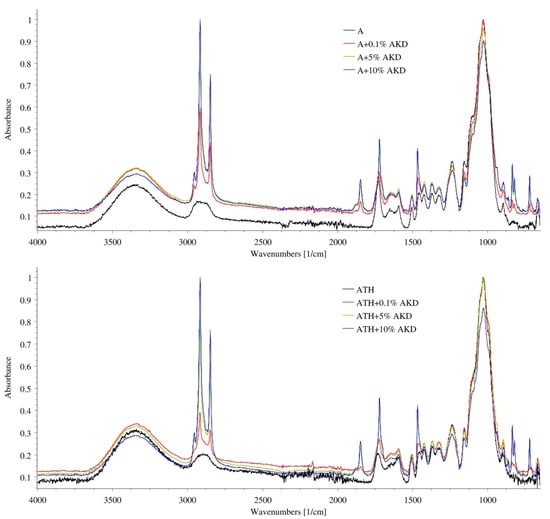
Figure 6.
Comparison of FTIR spectra of A (top) and ATH (bottom) with AKD.
The reaction mechanisms of AKD with wood fiber hydroxyl groups of cellulose were considered as an esterification reaction by Hubbe [23] and Seppänen [24]. The evidence of this reaction was the presence of the band at 1720 cm−1, indicating that the carbonyl groups originated from both the AKD and wood compounds. This band would underline the reaction between the AKD and wood surface since the band relative the stretching C=O in wood and in pure AKD was present at different wavenumbers.
As expected, the significant differences in intensity of the bands among a different concentration of AKD were recorded. Furthermore, there were differences between A and ATH samples immersed in AKD solutions, in particular at the concentration of 0.1% AKD. This was correlated to the thermo-treatment that destroyed and changed some chemical components of the cell walls that may act as binding sites [4,5]. Therefore, it could be assumed that the effect of AKD was significant, even at a low concentration of the solution.
After the weathering test, the analysis of ATR-FTIR showed some relevant differences (Figure 7). As previously discussed for Figure 4, the main changes occurred in the fingerprint area of the wood.
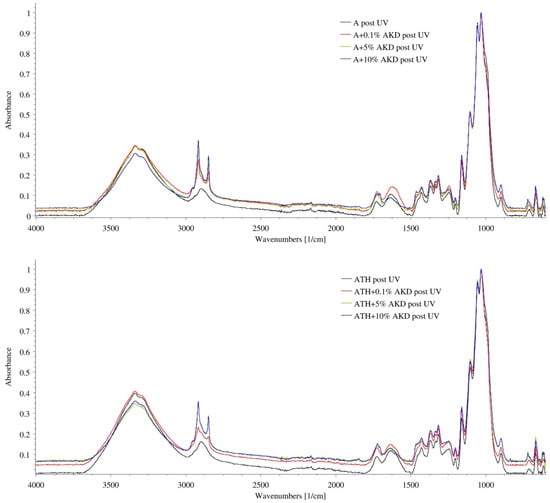
Figure 7.
Comparison of FTIR spectra of A (top) and ATH (bottom) with AKD after UV exposure.
The other relevant changes were displayed in the spectra: The bands ranging from 2850–2950 cm−1, which is typical of a AKD molecule; and the bands at approximately 1730 cm−1.
The 2915 cm−1 and 2848 cm−1 peaks which were C–H stretching vibration representing methyl and methylene groups of the alkyl chain in the AKD had a minor intensity in the spectra ATH + AKD post UV compared to A + AKD post UV. This could be dependent on the degradation of the methyl group of AKD. In the case of ATH samples, the C–H wood groups already modified by the heat treatment continue to alter further by lowering the intensity of this area of the FTIR spectrum. The band at 1730 cm−1 almost disappeared. The ester group, and thus the principal interaction between AKD and wood compounds, had been degraded by UV irradiation. Considering that the effect of waterproofing of AKD did not vary significantly, according to the WCA analysis, it could be assumed that there were other interactions more or less strong between the wood and wax AKD.
Several authors have demonstrated [26,27,28,32,33] that AKD has the potential to substitute other surface treatments to obtain a durable hydrophobic effect. Furthermore, AKD could be also used as an antifungal treatment [52]. In fact, the authors demonstrated that wood treated with AKD showed a promising resistance against G. trabeum, C. versicolor, P. placenta, but failed to prevent C. puteana attacks.
A previous study investigated the use of AKD to modify particleboard surfaces [53]. The authors stated that the hydrophobicity attained with AKD was due to esterification with wood hydroxyl groups and a subsequent orientation of the hydrocarbon chains [54]. Although FTIR-spectroscopy indicated ester formation, the strong absorption bands decreased after toluene extraction.
3.3. Colour Variation
The changing in natural coloration of wood and, in particular the darker tonality after heating (−26.39), can be attributed to the chemical reactions of oxidation or to the formation of a new compound by degradation of the wood component (Table 2). These results and the differences between the untreated and thermo treated samples before and after the weathering test, are largely discussed in a previous work [15].

Table 2.
The colour change (mean value) for both the treated and untreated alder. The colour variation of ATH samples are referred to A control samples.
After immersion of each sample in AKD solutions, the change in colour for the untreated samples are negligible. In case of thermo-treated wood, the total colour variation was due mainly to the modification of b* coordinate (−8.27 and −8.78).
The color change of the specimens in terms of ΔL, Δa, Δb and ΔE occurring after the weathering test are displayed in Table 3.

Table 3.
The colour change (mean value) for both the untreated and treated alder after the weathering test.
Alder wood, in both untreated and thermo treated samples, showed that AKD did not create a layer to protect and cover the wood by a photo-degradation. In fact, in terms of the total colour variation, no significant difference was depicted when AKD was used. On the contrary, compared to A and ATH, the wood surface covered by AKD seemed to be less appropriate to protect wood by photodegradation. For the ATH sample at an increasing concentration of AKD solution, the ΔL* increased and the surfaces were thus slightly lightened. The interaction of photon energy with the wood samples covered with AKD solution involves complex physical and chemical reactions only partially explained through ATR-FTIR analysis [15].
Our preliminary research presented an assessment of the effectiveness of the chemical modification of underused, untreated, and thermo-treated woods using AKD in improving its hydrophobicity. The AKD/water dispersions are commercially available and more environmentally friendly than toluene. However, the scope of this research was to highlight the main evidence of the relationship between AKD and alder wood surface.
4. Conclusions
- The untreated and thermo-treated wood samples treated with 0.1% of AKD had a significant decrease in WCA after the weathering test.
- The FTIR analysis showed that guaiacyl nuclei in the alder wood was more sensitive to heat degradation than syringyl nuclei.
- The presence of the band between 1720 cm−1 in the FTIR spectra before the use of UV could indicate the formation of the carbonyl groups originated from the reaction between AKD and hydroxyl groups of cellulose, making the surface water repellent.
- After the weathering test, the band between 1700 cm−1 and 1750 cm−1 in FTIR spectra disappeared, thus it could be assumed that there were other interactions, more or less, strong between the wood and AKD.
- The analysis of WCA showed that the investigated range of AKD, at 5% and 10%, did not differ in wettability also after weathering test. This evidence suggests that the optimal solution could be found in this range.
- In terms of colour variation, the results revealed that AKD in outdoor conditions was not very effective in restricting UV light induced degradation in the wood specimens.
Author Contributions
T.L. wrote most of the paper and performed the experimental testing; T.M. and N.M. performed part of the experimental testing; L.T. and W.G.-A. conceived and designed the study and revised the paper contributing to its drafting; all authors participated to the discussion of the work.
Funding
This research was funded by the PRIN2015 project (No. 2015YW8JWA) “Short chain in the biomass-wood sector: Supply, traceability, certification and carbon sequestration. Innovations for bio-building and energy efficiency”, coordinated by G. Scarascia-Mugnozza.
Acknowledgments
The authors would like to acknowledge the contribution of the COST Action FP1407. The Ph.D. program in “Agricultural, Forest and Food Science” coordinated by M. Borghetti, at the University of Basilicata, supported T. Lovaglio.
Conflicts of Interest
The authors declare no conflicts of interest. The funders had no role in the design of the study; in the collection, analyses, or interpretation of data; in the writing of the manuscript, or in the decision to publish the results.
References
- Todaro, L.; D’Auria, M.; Langerame, F.; Salvi, A.M.; Scopa, A. Surface characterization of untreated and hydro-thermally pre-treated Turkey oak woods after UV-C irradiation. Surf. Interface Anal. 2015, 47, 206–215. [Google Scholar] [CrossRef]
- Hingston, J.A.; Collins, C.D.; Murphy, R.J.; Lester, J.N. Leaching of chromated copper arsenate wood preservatives: A review. Environ. Pollut. 2001, 111, 53–66. [Google Scholar] [CrossRef]
- Hill, C.A. Wood Modification: Chemical, Thermal and Other Processes; John Wiley & Sons: Hoboken, NJ, USA, 2007; p. 260. [Google Scholar]
- Tjeerdsma, B.F.; Militz, H. Chemical changes in hydrothermal treated wood: FTIR analysis of combined hydrothermal and dry heat-treated wood. Holz Roh-und Werkst. 2005, 63, 102–111. [Google Scholar] [CrossRef]
- Kocaefe, D.; Poncsak, S.; Boluk, Y. Effect of thermal treatment on the chemical composition and mechanical properties of birch and aspen. BioResources 2008, 3, 517–537. [Google Scholar]
- Sandberg, D.; Haller, P.; Navi, P. Thermo-hydro and thermo-hydro-mechanical wood processing: An opportunity for future environmentally friendly wood products. Wood Mater. Sci. Eng. 2013, 8, 64–88. [Google Scholar] [CrossRef]
- Fengel, D.; Wegener, G. Wood: Chemistry, Ultrastructure, Reactions; Walter de Gruyter: Berlin, Germany, 1984; Volume 613, pp. 1960–1982. [Google Scholar]
- Altgen, M.; Willems, W.; Militz, H. Wood degradation affected by process conditions during thermal modification of European beech in a high-pressure reactor system. Eur. J. Wood Wood Prod. 2016, 74, 653–662. [Google Scholar] [CrossRef]
- Wikberg, H.; Maunu, S.L. Characterisation of thermally modified hard-and softwoods by 13 C CPMAS NMR. Carbohydr. Polym. 2004, 58, 461–466. [Google Scholar] [CrossRef]
- Boonstra, M.J.; Tjeerdsma, B. Chemical analysis of heat treated softwoods. Eur. J. Wood Wood Prod. 2006, 64, 204–211. [Google Scholar] [CrossRef]
- Mahnert, K.C.; Adamopoulos, S.; Koch, G.; Militz, H. Topochemistry of heat-treated and N-methylol melamine-modified wood of koto (Pterygota macrocarpa K. Schum.) and limba (Terminalia superba Engl. et. Diels). Holzforschung 2013, 67, 137–146. [Google Scholar] [CrossRef]
- Rowell, R.M.; Banks, W.B. Water Repellency and Dimensional Stability of Wood; US Department of Agriculture, Forest Service, Forest Products Laborator: Madison, WI, USA, 1985; p. 50.
- Petrič, M.; Oven, P. Determination of wettability of wood and its significance in wood science and technology: A critical review. Rev. Adhes. Adhes. 2015, 3, 121–187. [Google Scholar] [CrossRef]
- Huang, X.; Kocaefe, D.; Kocaefe, Y.; Boluk, Y.; Pichette, A. Changes in wettability of heat-treated wood due to artificial weathering. Wood Sci. Technol. 2012, 46, 1215–1237. [Google Scholar] [CrossRef]
- D’Auria, M.; Lovaglio, T.; Rita, A.; Cetera, P.; Romani, A.; Hiziroglu, S.; Todaro, L. Integrate measurements allow the surface characterization of thermo-vacuum treated alder differentially coated. Measurement 2018, 114, 372–381. [Google Scholar] [CrossRef]
- Rowell, R.M. Chemical modification of wood. Handb. Wood Chem. Wood Compos. 2005, 14, 381. [Google Scholar]
- Hui, B.; Li, Y.; Huang, Q.; Li, G.; Li, J.; Cai, L.; Yu, H. Fabrication of smart coatings based on wood substrates with photoresponsive behavior and hydrophobic performance. Mater. Des. 2015, 84, 277–284. [Google Scholar] [CrossRef]
- Ashori, A.; Babaee, M.; Jonoobi, M.; Hamzeh, Y. Solvent-free acetylation of cellulose nanofibers for improving compatibility and dispersion. Carbohydr. Polym. 2014, 102, 369–375. [Google Scholar] [CrossRef]
- Tserki, V.; Zafeiropoulos, N.E.; Simon, F.; Panayiotou, C. A study of the effect of acetylation and propionylation surface treatments on natural fibres. Compos. Part A Appl. Sci. Manuf. 2005, 36, 1110–1118. [Google Scholar] [CrossRef]
- Bismarck, A.; Tahhan, R.; Springer, J.; Schulz, A.; Klapötke, T.M.; Zeil, H.; Michaeli, W. Influence of fluorination on the properties of carbon fibres. J. Fluor. Chem. 1997, 84, 127–134. [Google Scholar] [CrossRef]
- Pouzet, M.; Gautier, D.; Charlet, K.; Dubois, M.; Beakou, A. How to decrease the hydrophilicity of wood flour to process efficient composite materials. Appl. Surf. Sci. 2015, 353, 1234–1241. [Google Scholar] [CrossRef]
- Yan, Y.; Amer, H.; Rosenau, T.; Zollfrank, C.; Dörrstein, J.; Jobst, C.; Li, J. Dry, hydrophobic microfibrillated cellulose powder obtained in a simple procedure using alkyl ketene dimer. Cellulose 2016, 23, 1189–1197. [Google Scholar] [CrossRef]
- Hubbe, M.A. Paper’s resistance to wetting—A review of internal sizing chemicals and their effects. BioResources 2007, 2, 106–145. [Google Scholar]
- Seppänen, R. On the Internal Sizing Mechanisms of Paper with AKD and ASA Related to Surface Chemistry, Wettability and Friction. Ph.D. Thesis, KTH Royal Institute of Technology, Stockholm, Sweden, 2007. [Google Scholar]
- Yoshida, Y.; Isogai, A. Preparation and characterization of cellulose β-ketoesters prepared by homogeneous reaction with alkylketene dimers: Comparison with cellulose/fatty acid esters. Cellulose 2007, 14, 481. [Google Scholar] [CrossRef]
- Yoshida, Y.; Heux, L.; Isogai, A. Heterogeneous reaction between cellulose and alkyl ketene dimer under solvent-free conditions. Cellulose 2012, 19, 1667–1676. [Google Scholar] [CrossRef]
- Song, X.; Chen, F.; Liu, F. Study on the reaction of alkyl ketene dimer (akd) and cellulose fiber. BioResources 2012, 7, 652–662. [Google Scholar]
- Yang, Q.; Takeuchi, M.; Saito, T.; Isogai, A. Formation of nanosized islands of dialkyl β-ketoester bonds for efficient hydrophobization of a cellulose film surface. Langmuir 2014, 30, 8109–8118. [Google Scholar] [CrossRef]
- Roberts, J.C.; Garner, D.N. The mechanism of alkyl ketene dimer sizing of paper, part I. Tappi J. 1985, 68, 118–121. [Google Scholar]
- Seo, W.S.; Cho, N.S. Effect of water content on cellulose/AKD reaction. Appita J. 2005, 58, 122. [Google Scholar]
- Bottorff, K.J.; Sullivan, M.J. New insights into the AKD sizing mechanism. Nordic Pulp Pap. Res. J. 1993, 8, 86–95. [Google Scholar] [CrossRef]
- Kumar, S.; Chauhan, V.S.; Chakrabarti, S.K. Separation and analysis techniques for bound and unbound alkyl ketene dimer (AKD) in paper: A review. Arabian J. Chem. 2012, 23, 1–7. [Google Scholar] [CrossRef]
- Shi, Z.; Fu, F.; Wang, S.; He, S.; Yang, R. Modification of Chinese fir with alkyl ketene dimer (AKD): Processing and characterization. BioResources 2012, 8, 581–591. [Google Scholar] [CrossRef][Green Version]
- Loewe, V.; Álvarez, A.; Barrales, L. Growth development of hardwood high value timber species in central south Chile, South America. In Proceedings of the 4th International Scientific Conference on Hardwood Processing, Delft, The Netherlands, 28–30 August 2013; p. 50. [Google Scholar]
- Praciak, A.; Pasiecznik, N.; Sheil, D.; van Heist, M.; Sassen, M.; Correia, C.S.; Dixon, C.; Fyson, G.; Rushford, K.; Teeling, C. The CABI Encyclopedia of Forest Trees; CABI: Oxfordshire, UK, 2013. [Google Scholar]
- Caudullo, G.; Mauri, A. Alnus cordata in Europe: Distribution, habitat, usage and threats. In European Atlas of Forest Tree Species; San-Miguel-Ayanz, J., de Rigo, D., Caudullo, G., Eds.; EU: Brussels, Belgium, 2016. [Google Scholar]
- Giordano, G. Tecnologia del Legno; I.N.A.P.L.I.: Roma, Italy, 1981; pp. 938–939. [Google Scholar]
- Salca, E.A. Black alder (Alnus glutinosa L.)—A resource for value-added products in furniture industry under European screening. Curr. For. Rep. 2019, 5, 41–54. [Google Scholar] [CrossRef]
- Salca, E.A.; Krystofiak, T.; Lis, B. Evaluation of selected properties of alder wood as functions of sanding and coating. Coatings 2017, 7, 176. [Google Scholar] [CrossRef]
- Todaro, L.; Rita, A.; Moretti, N.; Cuccui, I.; Pellerano, A. Assessment of Thermo-treated Bonded Wood Performance: Comparisons among Norway Spruce, Common Ash, and Turkey Oak. BioResources 2014, 10, 772–781. [Google Scholar] [CrossRef][Green Version]
- Christiansen, A.W. How overdrying wood reduces its bonding to phenol-formaldehyde adhesives: A critical review of the literature. Part I. Physical responses. Wood Fiber Sci. 2007, 22, 441–459. [Google Scholar]
- Repellin, V.; Guyonnet, R. Evaluation of heat-treated wood swelling by differential scanning calorimetry in relation to chemical composition. Holzforschung 2005, 59, 28–34. [Google Scholar] [CrossRef]
- Hillis, W.E. High temperature and chemical effects on wood stability. Wood Sci. Technol. 1984, 18, 281–293. [Google Scholar] [CrossRef]
- Kocaefe, D.; Poncsak, S.; Doré, G.; Younsi, R. Effect of heat treatment on the wettability of white ash and soft maple by water. Holz Roh-und Werkst. 2008, 66, 355–361. [Google Scholar] [CrossRef]
- Windeisen, E.; Strobel, C.; Wegener, G. Chemical changes during the production of thermo-treated beech wood. Wood Sci. Technol. 2007, 41, 523–536. [Google Scholar] [CrossRef]
- Aydemir, D.; Gunduz, G.; Altuntas, E.; Ertas, M.; Sahin, H.T.; Alma, M.H. Investigating changes in the chemical constituents and dimensional stability of heat-treated hornbeam and uludag fir wood. BioResources 2011, 6, 1308–1321. [Google Scholar]
- Colom, X.; Carrillo, F.; Nogués, F.; Garriga, P. Structural analysis of photodegraded wood by means of FTIR spectroscopy. Polym. Degrad. Stab. 2003, 80, 543–549. [Google Scholar] [CrossRef]
- Carrillo, F.; Colom, X.; Valldeperas, J.; Evans, D.; Huson, M.; Church, J. Structural characterization and properties of lyocell fibers after fibrillation and enzymatic defibrillation finishing treatments. Text. Res. J. 2003, 73, 1024–1030. [Google Scholar] [CrossRef]
- Evans, P.A. Differentiating “hard” from “soft” woods using Fourier transform infrared and Fourier transform spectroscopy. Spectrochim. Acta Part A Mol. Spectrosc. 1991, 47, 1441–1447. [Google Scholar] [CrossRef]
- Hon, N.S. Surface chemistry of oxidized wood. In Cellulose and Wood Chemistry and Technology; Schuerch, C., Ed.; John Wiley and Sons: New York, NY, USA, 1989; p. 1401. [Google Scholar]
- Liang, C.Y.; Marchessault, R.H. Infrared spectra of crystalline polysaccharides. II. Native celluloses in the region from 640 to 1700 cm−1. J. Polym. Sci. Part A Polym. Chem. 1959, 39, 269–278. [Google Scholar] [CrossRef]
- Suttie, E.D.; Hill, C.A.; Jones, D.; Orsler, R.J. Chemically modified solid wood. I. Resistance to fungal attack. Mater. Org. 1998, 32, 159–182. [Google Scholar]
- Hundhausen, U.; Militz, H.; Mai, C. Use of alkyl ketene dimer (AKD) for surface modification of particleboard chips. Eur. J. Wood Wood Prod. 2009, 67, 37–45. [Google Scholar] [CrossRef][Green Version]
- Odberg, L.; Lindstrom, T.; Liedberg, B.; Gustavsson, J. Evidence for β-ketoester formation during the sizing of paper with alkylketene dimers. Tappi J. 1987, 70, 135–139. [Google Scholar]
© 2019 by the authors. Licensee MDPI, Basel, Switzerland. This article is an open access article distributed under the terms and conditions of the Creative Commons Attribution (CC BY) license (http://creativecommons.org/licenses/by/4.0/).